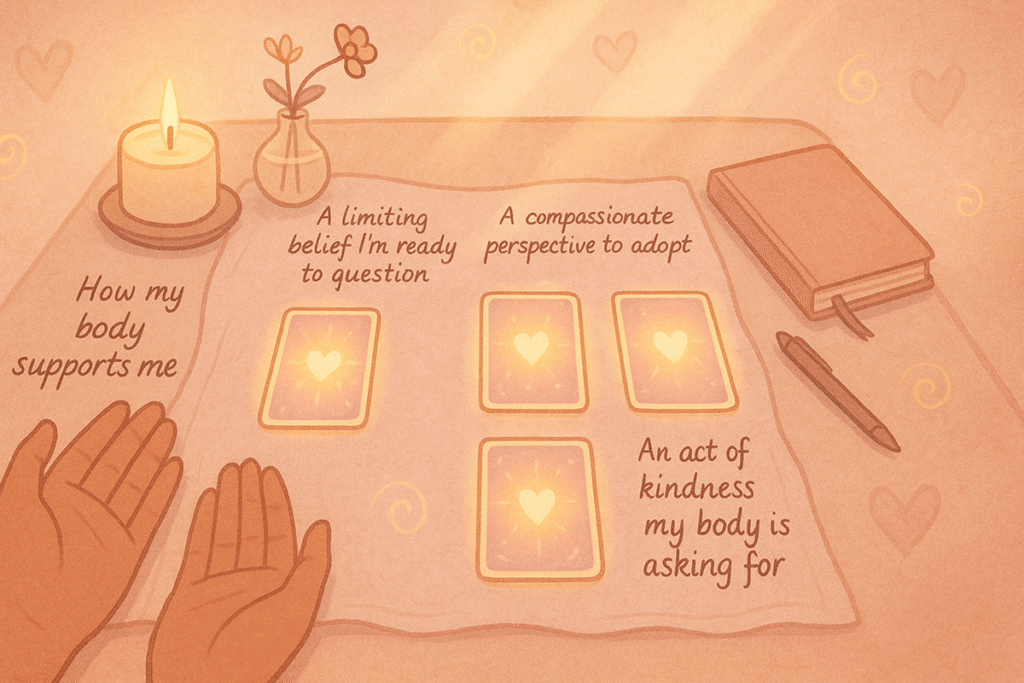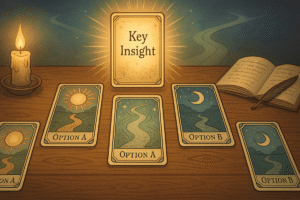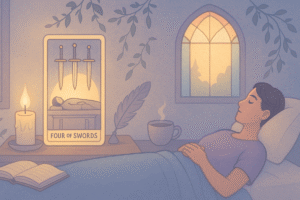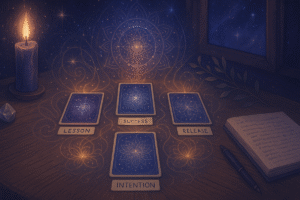Table of Contents
Our relationship with our bodies can be complicated. Maybe you’ve caught yourself being unnecessarily harsh in the mirror, or perhaps you’ve noticed that quiet voice of criticism that seems to know exactly when to speak up. I’ve found that tarot for self-acceptance offers something different from the usual advice about positive affirmations or self-love mantras. It creates space for honest reflection without demanding immediate transformation.
This particular spread isn’t about fixing anything or reaching some ideal state. Instead, it invites you to pause and genuinely listen to what’s happening beneath the surface. The questions we’ll explore together are designed to encourage curiosity rather than judgment, and I think that distinction matters more than we often realize.
Why Tarot Works as a Mirror for Body Compassion
Tarot cards have this interesting way of bypassing our usual defensive mechanisms. When you’re looking at an image on a card, asking yourself what it might mean in the context of your relationship with your body, something shifts. You’re not being lectured at or told what you should feel. You’re simply observing and reflecting.
The practice itself becomes a form of mindfulness. You’re creating a dedicated moment to check in with yourself, which is perhaps rarer than it should be in our busy lives. There’s no pressure to arrive at the “right” answer because, honestly, there isn’t one. What comes up for you today might be completely different from what surfaces next month, and that’s perfectly fine.
I think what makes this approach gentle is that it acknowledges complexity. Bodies change. Our feelings about them change. Some days are easier than others. Tarot for self-acceptance doesn’t pretend otherwise or rush you toward some glossy resolution. It meets you where you are.
Preparing Your Space and Mindset
Before laying out the cards, consider what kind of environment might help you feel safe and open. This doesn’t need to be elaborate. Maybe it’s your favorite chair with a cup of tea nearby, or perhaps a quiet corner where you won’t be interrupted. Some people like to light a candle or play soft music, though neither is necessary.
What matters more is your internal approach. You might notice resistance coming up even before you start. That’s completely normal. We’re not always ready to be kind to ourselves, and sometimes the idea of body compassion can feel almost threatening if we’ve spent years in patterns of criticism. If that’s where you’re at, just acknowledge it. You don’t have to feel differently right now.
Take a few deep breaths. Let your shoulders drop. Remind yourself that this is an exploration, not an examination. You’re not here to grade yourself or prove anything. The cards will simply offer prompts for reflection, and you get to decide what resonates and what doesn’t.
Shuffle your deck slowly. Some people prefer to focus on a question while shuffling, others let their mind wander. Either way works. When you feel ready, you’ll draw four cards for the four positions in this spread.
The Four Card Positions Explained
Each position in The Body Compassion Spread serves a specific purpose in building a conversation between you and your physical self. Think of it as creating a dialogue rather than seeking predictions or absolute truths.
Position One focuses on how your body supports you. This might seem obvious at first, but we often overlook the constant, quiet work our bodies do. Breathing happens without conscious effort. Hearts beat. Wounds heal. This position invites gratitude, though not the forced kind. It’s more about recognition and perhaps a gentle surprise at noticing something you’d taken for granted.
Position Two asks about a limiting belief you might be ready to question. Notice that word “ready.” Not all limiting beliefs are prepared to be challenged at any given moment, and that’s okay. This card might reveal something you’ve been suspecting was no longer serving you, or it might bring up something unexpected. Either way, the goal is awareness, not immediate demolition of long-held patterns.
Position Three suggests a compassionate perspective you might adopt. This is where the spread can feel quite tender. Sometimes the card here shows you something that feels almost too kind, too permissive. You might find yourself thinking, “But I can’t just think that way.” And maybe you can’t, not yet. But perhaps you can try it on, see how it feels, understand that this perspective exists as an option.
Position Four explores an act of kindness your body might be asking for. This could be something physical like rest or movement, or it might be more emotional or mental. Bodies don’t only need food and exercise. They need kindness, patience, and sometimes just acknowledgment.
Walking Through the Spread Step by Step
Let’s say you’ve drawn your four cards and they’re laid out in front of you. Now what?
Start with Position One. Look at the imagery on the card. What draws your attention first? Maybe it’s a color, a figure, a symbol, or the overall mood. Ask yourself how this might relate to the ways your body supports you. There’s no rush here. Let associations arise naturally.
Perhaps you’ve drawn The Star, and you find yourself thinking about hope and renewal. How does your body offer you that? Maybe it’s in the way sleep refreshes you, or how your body worked to recover from that cold last month. Or maybe The Star makes you think about aspiration, and you realize your body carries you toward the things you dream about, literally moving you through space toward your goals.
If nothing comes immediately, that’s fine too. Sometimes just sitting with the question is enough. You might jot down a few words in a journal, or simply hold the thought lightly in your mind.
Move to Position Two when you’re ready. This one can be trickier because limiting beliefs often disguise themselves as facts. The card here acts as a gentle revealer. If you drew The Devil, for instance, you might reflect on beliefs that keep you trapped or stuck in unhelpful patterns. What story have you been telling yourself about your body that maybe isn’t the whole truth?
I find that this position often brings up beliefs we inherited rather than chose. Things we heard when we were younger that somehow became internal scripts. The card doesn’t necessarily solve this, but it can make the belief visible, which is the first step toward questioning it.
Position Three offers something like a balm. After identifying a limiting belief, you’re shown a different angle. Say you pulled The Empress here. This card often speaks to abundance, nurturing, and natural cycles. The compassionate perspective might be that your body deserves nourishment and care simply because it exists, not because it meets certain standards or accomplishes particular things. That’s a radical shift for many of us.
You don’t have to fully embrace this new perspective right away. Just notice it. Consider what might be different if you could see yourself through this lens more often.
Finally, Position Four asks what kindness your body needs. This is practical but not prescriptive. If you drew the Four of Swords, maybe your body is asking for rest, stillness, or a break from constant doing. If it’s the Ace of Wands, perhaps there’s a craving for gentle movement or creative expression. The card points toward something, but you interpret what that means in your specific life with your specific circumstances.
Making This Practice Your Own
Some people find it helpful to revisit this spread regularly, perhaps monthly or whenever body image challenges feel particularly intense. Others might do it once and let the insights settle over time. There’s no prescribed frequency.
You could also adapt the positions based on what you’re working with. Maybe you need a position that asks about fear or one that explores joy. The structure I’ve offered is a starting point, not a rigid formula. Tarot for self-acceptance works best when it feels personal and relevant to your actual experience.
Keeping a journal specifically for these readings can be valuable, though again, not required. Looking back over time, you might notice patterns or see evidence of shifts you didn’t realize were happening. Sometimes we’re much harder on ourselves than necessary, and having a record can show us that we’re actually making progress, even if it feels slow.
When the Cards Feel Difficult
Not every card you draw will feel comfortable or immediately positive. That’s actually part of why this practice has depth. If you pull a traditionally “challenging” card in any position, resist the urge to shuffle it back in and try again.
Difficult cards often point to difficult truths we need to acknowledge. Maybe The Tower appears in Position Three, suggesting that the compassionate perspective involves recognizing that major shifts or losses have happened, and your body has carried you through them even when everything felt chaotic. That’s not comfortable, but it might be exactly what needs acknowledging.
Or perhaps The Ten of Swords shows up in Position Two, hinting at a limiting belief that involves feeling defeated or betrayed by your body. That’s painful to look at. But seeing it clearly, letting the card hold that feeling for you, can be strangely relieving. You’re not alone in it anymore. The card witnesses it with you.
This is where the gentleness of the practice really matters. You don’t have to fix or resolve everything the cards show you. Sometimes just seeing something clearly is enough work for one day.
Closing Thoughts on Compassion as Practice
I want to be honest about something. This spread won’t magically transform years of difficult relationship with your body into instant peace and acceptance. That would be unrealistic to promise. What it can do is create small moments of pause, tiny openings where self-compassion becomes possible.
Those moments add up over time. Each time you sit with these questions, you’re reinforcing a different way of relating to yourself. You’re practicing curiosity instead of judgment. You’re building the habit of asking rather than assuming.
Tarot for self-acceptance is perhaps most powerful in its ordinariness. It’s not dramatic or revolutionary. It’s just you, some cards, and a willingness to listen. But that simple act of listening, repeated with patience, can slowly reshape how you move through the world in your body.
Maybe that’s enough.
Frequently Asked Questions
Can I do this spread if I’m new to tarot?
Absolutely. This spread works well for beginners because each position asks straightforward questions that encourage personal reflection rather than complex card interpretation. Start by noticing what catches your eye in each card’s imagery, and let your first impressions guide you. There’s no wrong way to reflect on your relationship with your body.
How often should I use The Body Compassion Spread?
There’s no fixed rule, but many people find monthly check ins helpful, or whenever body image challenges feel particularly intense. Some revisit it during difficult periods, while others use it as a regular practice during new moons or season changes. Listen to what feels right for your journey, and remember that taking breaks between readings can allow insights to settle.
What if I draw a challenging or “negative” card?
Difficult cards often point to truths that need acknowledging rather than fixing immediately. A traditionally challenging card in any position might reveal something important about where you are right now, and seeing it clearly can actually be relieving. The practice invites you to witness what comes up without demanding you resolve it all at once, which is part of the gentleness this spread offers.
Can I modify the spread positions to fit my needs?
Yes, the structure is a starting point rather than a rigid formula. You might add a position about joy, change one to focus on gratitude, or adapt the questions based on what you’re working with currently. The spread works best when it feels personally relevant to your actual experience, so feel free to make it your own while keeping the compassionate, reflective tone.







